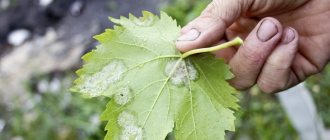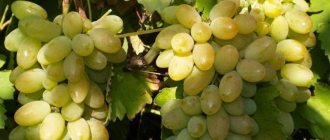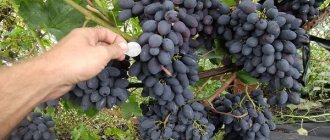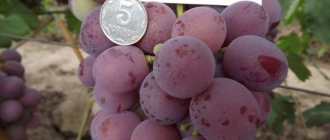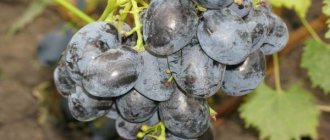Talisman was developed in 1990 and during this time has received recognition from many winegrowers. And with it - new names. The variety can often be found as Keshu, Super Keshu or Keshu Muscat. The last name is especially “telling” and emphasizes one of the characteristics of the grape – a light muscat aroma.
Grapes Talisman: variety description
The Talisman grape variety was developed by Russian breeders. It was bred back in nineteen ninety. The breeders who worked on it tried to give it high immunity and productivity. Currently, based on this variety, other varietal types of grapes are bred.
About the bush.
The Talisman grape bush itself is quite powerful; it has a lot of fruiting shoots. One or two clusters will be present on one shoot. If there are too many bunches, they will need to be trimmed. To prevent breakage of shoots, as well as pea crops. On one bush, you need to leave twenty-four to thirty-two eyes.
About flower stalks.
The Talisman grape variety has only female peduncles, so bushes with male peduncles or universal ones should be planted next to it. To pollinate the Talisman grapes in close proximity, you can plant bushes with flower stalks of different sexes.
About brushes.
As we already know, the clusters of the Talisman grape variety are quite powerful. On average, one brush will weigh eight hundred grams. The maximum weight can reach fifteen hundred grams, or twenty hundred grams. A bunch can reach its maximum weight with proper agricultural technology, that is, timely watering, regular fertilizing, and so on. The bunch itself is of a traditional shape, narrowed towards the bottom. And in structure they are dense, a little loose. If the brush is poorly singed, then empty spaces and gaps will appear.
About berries.
The berries of the Talisman grape are quite large and weighty. One berry can reach a weight of twenty grams. The shape itself is round, slightly elongated. On average, a berry will weigh twelve to fifteen grams. Its diameter is thirty-five millimeters. The color is soft greenish with a yellowish tint and a whitish coating. The inner flesh is tender and juicy. Those fruits of the Talisman grapes that will be exposed to direct sunlight will turn yellow over time. The peel, although dense, is still thin and unnoticeable.
Grapes Talisman: photo of the variety
Characteristics of the Talisman grape
Aging time.
The Talisman grape is a mid-early variety. The berries ripen one hundred thirty to one hundred and forty days after the start of the growing season. The speed of berry ripening depends on the region of growth. In the southern regions, berries will appear fifteen to twenty days earlier. In the northern regions, the berries will appear fifteen to twenty days later. In the regions of the central zone, the Talisman grape harvest can be harvested in early autumn.
About fruiting.
The first harvest from the Talisman grapes can be collected after twenty-four months after planting. Ripe clusters will hang and not fall off, and will not lose their taste until the first frost.
About reproduction.
Talisman grapes can be propagated using cuttings or layering. It should be noted that the survival rate is high.
Frost resistance.
The Talisman grape variety has a fairly high resistance to frost. It can withstand temperatures down to minus twenty-five degrees. But it is better to install a shelter for it in winter.
About taste.
Fully ripened berries have a nutmeg aftertaste and aroma. There is a lot of juice in the inner pulp of the fruit. The sugar content is twenty-four percent.
Disease resistance.
Talisman grapes are resistant to the most dangerous diseases of grape crops, that is, such as: 1) gray rot; 2) oidium; 3) mildew.
Salability.
Talisman grapes can often be seen on the shelves. Because it looks attractive in appearance and tastes sweet. It can withstand transportation over not very long distances. In this case, the bunches will not crumble, and the berries will not crack. The Talisman grapes themselves can be stored in refrigerators at a temperature of plus eight degrees for one hundred twenty to one hundred and eighty days.
Grapes Talisman: photo of the variety
Reviews
Vladimir V., Krasnodar I have been giving preference to Talisman for several years now. It always produces a good harvest and is not afraid of diseases. When other varieties fall from mildew, my Talisman stands and ripens. I am planning to expand the vineyard. I will definitely plant a few more rows of Talisman.
Olga N., Moscow region Not every variety takes root in our region, but Talisman was a pleasant surprise. We cover the vine for the winter and emerge from the frost with virtually no losses. In September, you already have your own berries that can be in the refrigerator. I do conservation and also experiment with light wines.
Galina M., Belgorod I think that the Talisman is for the south. All my attempts to achieve full ripening of the berries were unsuccessful. It takes root perfectly, grows quickly, I just have time to pick off the cuttings, the berries are large, but they don’t achieve the varietal taste, you can’t eat a lot of it - you don’t want to.
Secrets of planting grapes Talisman
Grapes Talisman: photo of the variety
When planting the Talisman grape variety, you can use standard agricultural techniques. The most important thing is to take into account the area, since the bushes will be massive, that is, they need a large space for comfortable growth and development. There should be a distance of three hundred centimeters between neighboring crops. Talisman grapes can be planted in any strip, it is only important to observe the conditions of sufficient warmth and lighting. The largest harvest will occur after a hot and fairly sunny summer period.
How to choose the best place to plant Talisman grapes
- The most suitable type of soil is considered to be chernozem. But planting can also be done on other soils, which will first be fertilized with organic or mineral fertilizers.
- It is impossible to plant grapes in lowlands, in swampy or uneven areas where liquid often stagnates, and where groundwater flows nearby. Since waterlogging the soil can cause rotting of the root system.
- If the soil has a high percentage of acidity, it must be neutralized with wood ash. The ash must come from clean wood, that is, not painted, not glued, not varnished.
- You need to choose a place in the southern or southwestern area of the garden. This way the talisman grapes will receive the maximum amount of heat and lighting.
- When choosing a location, you need to focus on the area where a high percentage of sunlight is concentrated.
- There should be no cold drafts or strong wind currents at the landing site.
- When planting, you need to ensure that the seedlings are covered on the north side by a fence or building or some other fence.
- Groundwater must lie at least two hundred and fifty centimeters from the soil surface.
How to prepare a hole.
Grapes Talisman: photo of the variety
- The planting hole must be dug in the shape of a square, with sides of seventy to eighty centimeters.
- The hole needs to be filled fifty percent with a nutrient soil mixture.
- You need to lay out a drainage layer at the very bottom of the hole. It can be made from coarse crushed stone, expanded clay, or fine pebbles. It will protect the plant’s root system from waterlogging and also reduce the risk of rotting.
- You need to install a small pipe in the prepared hole, through which watering will take place.
How to prepare a nutritious soil mixture.
To do this you need:
- two buckets of rotted manure;
- two buckets of wood ash. The ash must be from pure wood, that is, not painted, not glued, not varnished;
- three hundred grams of superphosphate.
All this must be thoroughly mixed and placed in the hole.
What should be the distance between the holes and the beds.
You need to plant Talisman grapes taking into account all its features. There should be a distance of four hundred centimeters between the bushes. This is the most optimal distance for comfortable growth and development of the root system and the plant itself. If the soil is not very rich, then the distance needs to be increased to four and a half to five hundred centimeters. This will allow the bushes to receive more nutrition from the soil. If you plant the crop in rows, then the distance between the bushes should be five to six hundred centimeters.
When to plant.
The most suitable time is considered to be autumn. Namely its middle. You can also carry out the planting procedure in the spring season. There is no significant difference between them. Usually, when choosing a planting time, gardeners start from the moment they purchase the seedlings.
The nuances of planting Talisman grapes in spring
If planted in early spring.
At the end of the first month of spring, Talisman grape seedlings with dormant buds are usually planted, cuttings are also grafted, and grapes are propagated through layering.
If planted in mid-spring.
At this time, namely in the second month of spring, green seedlings are planted and cuttings are grafted.
The most favorable days for planting Talisman grapes
Experienced gardeners recommend following the lunar calendar.
- Pleasant days for planting in the first month of spring are: 1) 2; 2) 3; 3) 8; 4) 9; 5) 10; 6) 11; 7) 12;
 13; 9) 16; 10) 23; 11) 24; 12) 25.
13; 9) 16; 10) 23; 11) 24; 12) 25. - Pleasant days for planting in the second month of the spring period are: 1) 2; 2) 3; 3) 7; 4) 8; 5) 9; 6) 10; 7) 11;
 12; 9) 13; 10) 17; 11) 22; 12) 23; 13) 24.
12; 9) 13; 10) 17; 11) 22; 12) 23; 13) 24. - Pleasant days for planting in the first month of spring are: 1) 2; 2) 3; 3) 4; 4) 5; 5) 6; 6) 7; 7) 8;
 12; 9) 17; 10) 18; 11) 19; 12) 30.
12; 9) 17; 10) 18; 11) 19; 12) 30.
Forum statistics
207033 Messages in 1634 Topics from 5593 Users. Latest user: Amaya Latest message: “Ripening dates are different...” ( Today at 00:37:47 ) Latest messages on the forum.
Now on the forum
35 Guests, 7 Users
Users in the last 15 minutes: znakomij, Alexander K, Vardan, Sergey Fer, Alexey V, Anatoly Sivkov, yotmast [Blocked] [Section Moderator] [Forum Moderator]
Maximum online today: 77 . All-time maximum online: 2758 (28 July 2021, 17:22:51)
Users who visited the forum in the last 24 hours
Total: 300
(Visible: 299, Hidden: 1) 1963, znakomij, Alexander K, Vardan, Sergey Fer, Anatoly Sivkov, yotmast, Alexey V, Ilya 77, Andrey gladilin, Tatyana A., Belgorodets, in Astrakhan, hanter64, Oksana Kopp, Tatyana B, sem_en, Alex65, Vladimir 153, skier, Igor Viktorovich, slavalimon, Alexander Vl., Primorets, OlgaOs, SANYCH, 31rus, mystic69, DorontsovPeter, Andrey Tsvetkov, Buba, Cherkessk, igor222, Andrey76, Elena Z, vlad51, Kenig, Nikolay Rex, Sergey 1965, Vladimir Buturlakin, DSW, psv1960, Dmitry 77, Vasily V., Vyacheslav03, Natalia Nikolaevna, Sergey Tashchiyan, Nikolay S., Igor Sergeevich, alexsandr, kvg, Pioneer, Ekaterina Polyanina, nicson7, Elena Aleshchenko, Alexander -ask-34, Verona, Igor F., Taker, Tikhy, Henry, Yuri72, L.A.P., Gaivoronsky Yuri, Sergeevich, Sergey Chistokletov, Svetlana Streletskaya, Galinka, Alexey Deminov, Naumov Igor, Vyacheslav136, Gloomy, Katrin , AndSanych, vladimirM, Mikhno Alexander, Ded31, Filippov Oleg, Vladimir ++, Svetla777, Mikhail Alekseevich, Lydia58, Mikhail77, ALEXANDER BRYANSKY, Vladimir-kanevskaya, leonidych, DIL, Amber7394, Marina Protasova, TITOVA LYUBOV, Linx, alexander66, Natalya M, Mikhail Fesenko, ElenkaF, Amaya, Alexander71, Boris 1952, tsv, Maximilian, 25nata35, nadia, GALINA ANOKHINA, Igor_K, Alexander Kolesnikov, Ivan Levin, Pitko, weather forecaster, eSAa, cecet71, atseton, Alexander Smirnov, Vladimir Kostochkin, Vladimir Berdnikov, Gocha, pioneer-2, mers, LeXa_KoT, Sergey 61, Sergey Yuryev, Erem, alexss, Evgeniy52, Skif, lomakin1969, Vladimir Kovba, dayton, Yuri Semyonov, N.A. Sokolov, Pavlentiy, Sa-shura, Volgogradka, Dmitry Anatolyevich, Grandfather Igor, Andrey Lis, Bublichenko Alexander M, Marina Krymskaya, stenlly2010, irahelm, Vyacheslav Vladimirovich, Vladimir Shilov, Aprel, Dmitry Badaev, gheo55, Yura, y_fed, rambo, Yagodka, Valentina Ivanovna, Kryn, oleg9f, DED2, Korotina Svetlana, Delivered Oleg Ivanovich, Eduard., santra, L2k2m7n, Alexander48, Viknik, Andrey 31, m2d, Marshal, Valery Rastorguev, Serg1707, Soshnin Yura, Amateur gardener, Galina, Vasily1111, gardener, marlin64, Salex, sergei, Sergey Ko, Ramiz, victor_, kosmos, potap05, Yuri 36, VitaliySD, Inna161, Vova Kapran, Vladimir Shcherbinin, Valerie, niy1, cfibr, Andrey68, Elvira2017, kulol3, Slavka, thanatos, Serzh1978, Realist, Artur53, max2008-01, LOZA , AlexanderD, Grandfather Young, Natasha, Zayac, ketch, Rita, alx-74, Iv Iv, Alexander150, Igor K, SNovichek, Vasily Viktorovich, VeraNiK, kdm57, Veniaminovich, Boris Sokolyansky, therapist, Capricorn, 77volt, , vikbublik, neposny , Evgen, Victoria Aleksandrovna, Serezha 64, Wintel, Airbone, teri, Sergey Lomonosov, Khramov, serginio, Leonty Yarygin, Irina O., Ser, Nadezhda Grig, zsb, Lyubov S., netolya, Saisan, Agryzkov Alexey, Vadi, Zinaida , Vadim, Alexander Taganrog, Sukhonon Sergey, Snezhinets, Evgen_26, NAU_63, Masha_Sadovod, Gennady163, Krasnovlad1, Alexander Zinoviev, Vasily 53, Roman Fedorovich, Tis, Alexey Sergeyevich, Arnya, Zhek, Nurtas, Kradievska, 64nikolay64, Nick041, Li, Nick041, Li, Nick041, Li, Nick041, Li ZA, Valentine Medvedeva, Sergey43, Andrey S., Nikolay Lipunov, Mst, Vertuoz2, Vladimir VS, NatalyaMed, freesia, Kinna, Mikhail Michurinsk, alekcsan1, VALERY TAMB, Sasha57, MikhAf, Y_Azer, Andrey Beribesov, hunter1955, nut lover, Keys, Ivan Shmelev , Pestle, anton_slash, Nadymchanka, Sergey 31, Volgar, Pavel 64, Tatyana Volzh, Elektronik_t, Alexander 61, spotlight, Alexander Gai, Cheprak, Pirko Alexander, vladimirvrn, Antrikan, asun16, Alexey Viktorovich, YurSanych, bairina, Lekseich
Secrets of caring for the variety
Talisman grapes do not require special care. You just need to follow agrotechnical rules. And of course, you need to prune as the bush gets busy. Also develop a suitable watering regime, timely loosen, destroy weeds, and mulch the soil. Fertilize and cover before winter, if circumstances require it.
Fertilizers and fertilizing.
The Talisman grape variety needs fertilizers and fertilizing, because its bushes are quite powerful and consume a huge amount of nutrients, microelements and macroelements from the soil while they are growing and developing. From spring to winter, you need to carry out five root feedings and two foliar feedings.
- The first feeding should be of the root type, it should be done seven to fourteen days before the plant begins to bloom. You can produce it like this: for one square meter of soil, you need to add forty to fifty grams of nitrophoska. It is produced so that the plant is better pollinated and the clusters grow larger.
- The second feeding is carried out foliar type. It produces it two to three days before the plant begins to bloom. It is carried out with the aim of improving the pollination of the plant, as well as reducing the risk of ovary shedding. How to produce it: 1) ten to twelve liters of clean water at room temperature; 2) ten to twenty grams of boric acid; 3) twenty grams of copper sulfate; 4) Two to three grams of iron sulfate. All this must be thoroughly mixed and mixed with the selected fungicidal preparation.
- The third fertilizing is carried out by the root type. It is applied ten to fifteen days after the plant has flowered. It is produced in order to support the growth and development of crop shoots, as well as fruits. To do this, you need to add thirty to sixty grams of nitrophoska per square meter of land.
- The fourth feeding should be done foliar type. It is produced when the berries are already small in size. It produces it in order to reduce the risk of chlorosis, as well as ridge paralysis. To do this, per one square meter of soil you need to add: 1) thirty to forty grams of urea; 2) ten to fifteen grams of iron sulfate; 3) one gram - potassium permanganate; 4) twenty grams of citric acid.
- The fifth fertilizing is done by the root type. The producer needs it seven to fourteen days before full harvest. With its help you can prevent cracking of berries, as well as improve their taste. It will also help speed up the ripening of those fruits that have received little light. You can reproduce it using: 1) twenty grams of superphosphate; 2) fifteen grams of potassium salt; 3) one tablespoon - potassium magnesium.
- The sixth feeding should be of the root type. It must be produced before the berries ripen. It will help reduce the risk of gray rot and also improve the taste of the fruit. To do this you need: mix wood ash with one or two microfertilizer tablets, and then dilute it all in ten to twelve liters of clean water at room temperature. The ash must come from clean wood, that is, not glued, not painted, not varnished.
- The seventh fertilizing should be of the root type. You need to produce it after you harvest the crop. It allows you to improve the ripening of young shoots. To do this you need: 1) twenty to thirty grams of potassium sulfate; 2) thirty to forty grams of superphosphate.
What is the pruning procedure and the most favorable periods for it.
The pruning procedure is a very important agrotechnical process in caring for Talisman grapes.
- Pruning of the Talisman grape variety in the spring must be done after sap flow begins in the plant. During this event, you need to trim off damaged, shriveled, undeveloped and deformed shoots.
- Summer pruning is carried out throughout almost the entire summer period. It consists in the formation of bushes. During such an event, it is necessary to remove excess shoots, foliage and ovaries.
- Autumn pruning of Talisman grapes is done after the leaves have fallen. Each shoot will need to be shortened until there are seven eyes left on it. You also need to take into account that only thirty-two buds should remain on each bush.
Preparing for winter.
Grapes Talisman: photo of the variety
In the autumn, the crop needs to be removed from the trellis, tied in an improvised bundle, and then spread out on the soil and covered with spruce branches. In regions with harsh winters, gardeners use slate or roofing felt. With the arrival of spring, all shelters are dismantled.
Care and cultivation
In the first year after planting, grapes require constant watering and 2-3 times treatment of the vine with fungicides. Later, during the season, it is necessary to remove excess shoots, thereby giving the bush the correct shape.
Twice a year the vine requires abundant watering (13-14 liters of water): the first time - before the buds swell, the second time - after the grapes have flowered. For normal crop growth, it is enough to apply phosphorus-potassium fertilizers once.
During the season, it is necessary to regularly mulch the soil using manure. Dried stems and defective branches should be removed, otherwise the speed of plant development will decrease. Pruning is carried out in early spring or autumn.
All branches, including those attached to the support, must be removed and laid to the ground before the onset of frost. For reliable fixation, it is recommended to use wire. After this, the vine needs to be covered with leaves or dry branches, and plastic film placed on top.
To speed up fruiting, use a woody cutting, which is kept for 30 seconds in a 1-3% solution of copper sulfate and then grafted onto the plant.
Possible diseases
The Talisman grape has a fairly high resistance to various diseases. It is quite rarely affected by the most well-known diseases, for example, such as: 1) gray mold; 2) white rot; 3) oidium; 4) anthracnose; 5) mildew. If preventive measures are taken in a timely manner, the risk of contracting various diseases is significantly reduced.
Black spotting is a fungal-infectious disease. When it appears, black dots may appear on the foliage and then on the branches. If the leaves of the grapes have already fallen, then you can spray them with copper sulfate with a three percent concentration. If the plant is at the stage when it has already formed three to five leaves, and the buds are already blooming, then it can be treated with fungicidal preparations, for example, with a product such as quadris.
Table of main parameters of the hybrid form:
| Variety | name "Talisman" |
| Frost resistance | -24 -25′ C |
| Disease resistance | Average 3 points |
| Pea planting | No |
| Sugar content | high, 18-20% |
| Aroma | slightly nutmeg harmonious |
| Raw materials for wine | Yes |
| Consumed raw | yes, table variety |
| Transportable properties | Medium, can be transported over short distances |
| Craving for the earth | Fertile sandy soils. Does not tolerate proximity to groundwater. |
| Productivity | Tall, over 40 kilograms |
| Color | The color of the berries ranges from white-green to amber-yellow. |
| Shape, size of berries, weight of berries | The berries in the cluster are equal in size, olive-shaped. Length is about 25-40 millimeters, width – 20-30 millimeters. The grapes reach a weight of 14-25 grams. |
Possible insect pests.
Although Talisman grapes are resistant to many diseases, insect pests can still damage them.
The insect pest is phylloxera.
This is a very small insect measuring one to one and a half millimeters in size. Attacks all parts of the plant. When it appears, the plant must be quarantined. You can treat it with karbofos or confidor.
The insect pest is the spider mite.
This is an arachnid insect, its size reaches half a millimeter. It attacks the foliage of the plant, sucking out the nutritious juice from it. Due to their appearance, the foliage begins to turn yellow, dry out, and then fall off. You can fight with the help of Akarin or Actellik. Also, the affected parts of the plant must be destroyed.
Insects - wasps.
Wasps are a huge danger to this type of grape due to its high percentage of sugar content. If there are not so many insects, then you can hang water with sugar and poison dissolved in it between the rows. If there are too many wasps, then each vine needs to be protected with a net.
Recommendations for successful pollination of Talisman grapes
Grapes Talisman: photo of the variety
In order for the Talisman grapes to bring a lot of harvest, it must be well pollinated. There are several recommendations for this.
- Near the Talisman grape variety, you need to plant a related crop with bisexual inflorescences. It is important to select a variety so that it blooms at the same time as our variety. The most suitable varieties are considered: 1) Odessa souvenir; 2) Isabella and many others.
- Before the Talisman grapes begin to bloom, they need to be treated with preparations that contain zinc and boron elements. For example, you can use: 1) ovary; 2) boroPlus and many others.
- When the bush is flowering, it would be a good idea to spray it with hederelin. This treatment will prevent the ovary from falling off and will also ensure that the fruits are seedless. The concentration should be as follows: fifty milliliters of product per liter of water.
Grapes Talisman: video about the variety
Grapes Talisman: reviews from gardeners about the variety
- Ekaterina Andreevna, Samara region: “Talisman has found a huge number of advantages in growing grapes: the berries are quite large, the fruit-bearing clusters are large, the Talisman grapes have the taste and aroma of muscat, and are resistant to many diseases, as well as frost. And of course, the high yield of Talisman grapes allows us to call it one of the most worthy grape varieties.”
- Stepan Viktorovich, Chelyabinsk region: “Of course, the Talisman grape variety has a large number of advantages, but I want to focus on some inconveniences in growing the variety: Talisman grapes require pollinators, or planting seedlings with inflorescences of the opposite sex; needs to trim off excess inflorescences so that the shoots do not break off and the berries do not become smaller. Also, the fruits of the Talisman grapes are very attractive to insects such as wasps and hornets, and birds are not averse to pecking away the entire harvest. However, how you can use the Talisman grape variety for me covers all the shortcomings. Thus, the berries of the Talisman grape variety can be eaten fresh, made into wine, added to desserts and even made into marinades.”
History of variety development
This variety of grapes was created by Kuban breeders. This culture is a hybrid. The latter was obtained by crossing the Moldovan variety White Beauty and Delight. Moreover, the latter was also developed at the Kuban Institute.
The name Kesha is not only used for this variety. There are several cultures with the same name that have similar characteristics.
The variety has retained the features inherent in its parent forms. In particular, grapes have gained the ability to withstand the effects of many diseases, and ensure high yields of each vine.
